British Toy Companies : Dublo Dinky Toys
DUBLO DINKY TOYS
.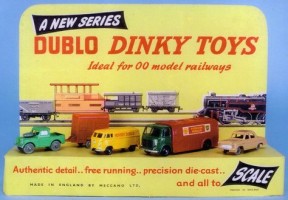
In November 1958, Meccano Ltd introduced the Dublo Dinky range of models to run alongside its popular Dinky Toys range. The Dublo series of vehicles was produced in 1:76 / OO scale and was initially designed to be used in line with the Hornby railway system but was also aimed to compete directly in the small-scale toy car market which at that time was dominated by Lesney’s Matchbox.
The Dublo range was relatively cheap to produce having a one-piece die-cast metal body with a simple metal base plate and either smooth or treaded plastic wheels.
The Dinky Dublo range consisted of just 15 basic models although with upgrades and modifications that figure would increase to something like 42 variations. There were no colour changes throughout the short life of Dublo and all models came boxed.
The Dublo range met with only limited success so much so that the first model was withdrawn in October 1960 having only been on sale for just 18 months ! The writing was on the wall as yet further models were withdrawn over the following three years until finally in November 1963 those models that still remained in the range were also discontinued, a mere six years after the Dinky Dublo line was introduced.
Thus ended the production of Dublo Dinky Toys under Meccano who themselves went into receivership some two years later.
DUBLO DINKY TOYS – Model List
 .
.
061 FORD PREFECT
Fawn bodywork finish with silver trim
Grey smooth plastic wheels, tin base plate
Introduced 1958 – Withdrawn 1960
.
 .
.
062 SINGER ROADSTER
Orange bodywork finish with red interior, silver trim
Grey smooth plastic wheels, no base plate
Introduced 1958 – Withdrawn 1960
.
 .
.
063 COMMER VAN
Blue bodywork finish with silver trim
Grey smooth plastic wheels, tin base plate
Introduced 1958 – Withdrawn 1960
.
 .
.
064 AUSTIN LORRY
Green bodywork finish with silver trim
Grey or black smooth plastic wheels
Introduced 1957 – Withdrawn 1962
 .
.
.
065 MORRIS PICK-UP
Red bodywork finish with silver trim
Grey plastic smooth or tread wheels, no base plate
Introduced 1957 – Withdrawn 1960
 .
.
.
066 BEDFORD FLAT TRUCK
Grey bodywork finish with silver trim
Grey smooth plastic wheels
Introduced 1959 – Withdrawn 1966
 .
.
.
067 AUSTIN TAXI
Blue lower body, cream upper body finish with silver trim
Plastic wheels black or grey tread, smooth grey plastic wheels
Introduced 1959 – Withdrawn 1964
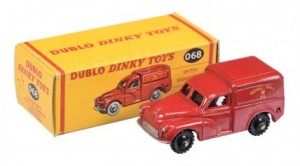 .
.
068 MORRIS VAN ‘ROYAL MAIL’
Red bodywork finish with silver trim and royal crest
Grey or black plastic wheels with tread
Introduced 1959 – Withdrawn 1964
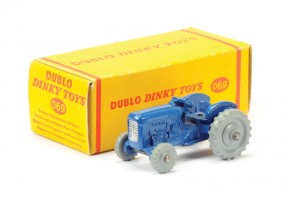
.
.
069 Massey Harris Tractor
Blue bodywork finish, hole for driver, tow hook
Grey plastic wheels with tread
Introduced 1969 – Withdrawn 1964
 .
.
.
070 AEC MERCURY TANKER – Shell / BP
Green cab with red tank
Black or grey plastic wheels with tread
Introduced 1959 – Withdrawn 1964
 .
.
.
071 Volkswagen Delivery Van
Yellow bodywork finish with silver trim, red ‘Hornby Dublo’ lettering
Black or grey plastic wheels with tread
Introduced 1960 – Withdrawn 1964
 .
.
072 BEDFORD ARTICULATED TRUCK
Yellow cab with red semi-trailer
Smooth grey, grey or black plastic wheels with tread
Introduced 1959 – Withdrawn 19964
.

073 LAND ROVER and HORSE TRAILER with Horse
Green car with green or orange trailer, tan or white horse
Smooth grey, grey or black plastic wheels with tread
Introduced 1960 – Withdrawn 1964
.
074 THIS NUMBER WAS NEVER USED
Intended to be allocated to a separate Land Rover model which was never issued
075 THIS NUMBER WAS NEVER USED
Intended to be allocated to a separate Horse Box model which was never issued
 .
.
076 LANSING BAGNALL TRACTOR & TRAILER
Maroon tractor/trailer, blue driver/seat
Black plastic wheels smooth or with tread
Introduced 1960 – Withdrawn 1964
.
.
077 THIS NUMBER WAS NEVER USED
Intended to be allocated to an AEC Transporter model which was never issued
 .
.
078 LANSING BAGNALL TRAILER
Maroon bodywork finish with wire drawbar & tow hook
Black plastic wheels smooth or with tread
Introduced 1960 – Withdrawn 1964









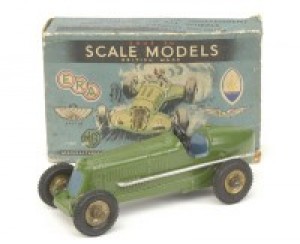

 The illustration that first caught my eye and sent me along this pointless path was the one shown opposite !
The illustration that first caught my eye and sent me along this pointless path was the one shown opposite ! to deliver a message from Wingate, Bunter decides to
to deliver a message from Wingate, Bunter decides to Sitting in Mr. Quelch’s armchair, Bunter opened that pot of jam. Unluckily he had no spoon, but on Mr. Quelch’s table lay a paper-knife which answered the purpose fairly well. With that implement Bunter scooped out jam and conveyed it to a large mouth : and chunk after chunk of delicious plum jam followed the downward path. It was a happy, sticky Bunter that cleaned out the jam-jar with the ivory paper-knife.
Sitting in Mr. Quelch’s armchair, Bunter opened that pot of jam. Unluckily he had no spoon, but on Mr. Quelch’s table lay a paper-knife which answered the purpose fairly well. With that implement Bunter scooped out jam and conveyed it to a large mouth : and chunk after chunk of delicious plum jam followed the downward path. It was a happy, sticky Bunter that cleaned out the jam-jar with the ivory paper-knife.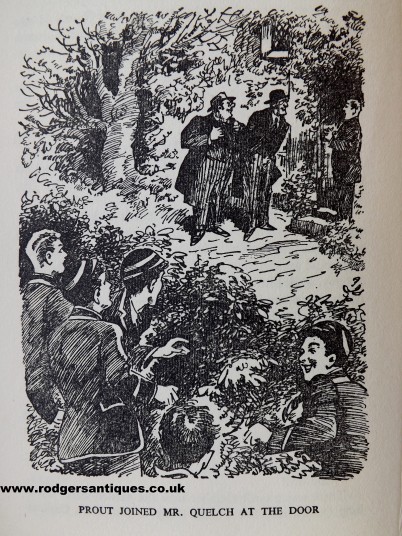



 .
. .
.


 December 1966
December 1966 




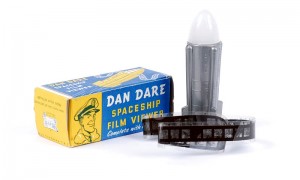



 was originally founded in 1933 by Phillip Ullmann who had settled in the UK the year before. Ullmann came to the UK from Germany where he had set up the renowned tinplate toy company Tipp & Co., based in Nuremburg. Ullmann was initially given space to work in a subsidiary company of Bassett-Lowke, a company highly respected in engineering model making. He was joined soon afterwards by Arthur Katz, who also had a background with the German toy makers Tipp & Co. The Mettoy name itself was derived from METal TOY, the company being initially involved in producing tin plate toys, from a factory based in Stimpson Avenue, Northampton, employing a workforce of around 50. By 1937 the company had expanded into larger premises 4 miles away in Harleston Road.
was originally founded in 1933 by Phillip Ullmann who had settled in the UK the year before. Ullmann came to the UK from Germany where he had set up the renowned tinplate toy company Tipp & Co., based in Nuremburg. Ullmann was initially given space to work in a subsidiary company of Bassett-Lowke, a company highly respected in engineering model making. He was joined soon afterwards by Arthur Katz, who also had a background with the German toy makers Tipp & Co. The Mettoy name itself was derived from METal TOY, the company being initially involved in producing tin plate toys, from a factory based in Stimpson Avenue, Northampton, employing a workforce of around 50. By 1937 the company had expanded into larger premises 4 miles away in Harleston Road.








